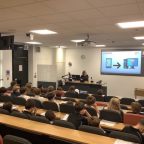
How Technology is Making Education Accessible for All
The technological evolution and digitization of the world of academia have been the greatest win of the decade for everyone. This evolution has not just helped make education accessible to students where it was geographically impossible before, but has also optimized many of the academic tasks now for many students. Ever since the great shift of traditional education methods to online, we have seen various academic help platforms emerge as well. Click Here.
Where technology is helping a student in India take a class online from an institute in the UK, it is also helping an overwhelmed Master's student have their research paper done by a dissertation writer online. So it seems that technology is not advancing just to make education accessible to students geographically, but also conceptually. In this blog, we will discuss in detail how technology is making education accessible to everyone dissertation writer.
How Has Technology Revolutionized Education?
Technology has helped break barriers that restricted a lot of aspiring students with physical, cognitive, or socio-economic difficulties. Technology has made effective tools that enhance and support learning efficiently. With assistive technologies, adaptive learning platforms, and digital resources, education has become possible for students with disabilities, those living in third-world countries, and even students who are balancing work with their studies.
Online Education
First and foremost, having the traditional learning move online carved a path for many other opportunities in the educational field. Students who were located in areas with no quality education providers are now able to access courses and programs offered by the top institutions in the world. Harvard, Yale, MIT, and many other renowned names are offering massive open online courses (MOOCs). Most of them are free to access for learning and even offer an optional paid certificate. Apart from these, there are several virtual universities offering degrees through online semesters.
This has assisted students who need to take full-time jobs to be able to support themselves. Online classes give them the flexibility to take the class from anywhere and take more jobs, as at times the institute offers them the option to choose the time slots. Many virtual universities provide students with portals where they upload their lectures, and students can catch up with learning when they are done with their daily chores. This ease is helping struggling students save up on resources and expenses that are necessary for traditional learning classrooms and have more time to give to their full-time jobs.
Assistive Technology
Often, aspiring and smart students are held back from acquiring education due to their physical disabilities, but ever since the development of assistive devices, more and more kids are given a chance at making it to their dream career. These devices meet the requirements of scholars with impairments, such as screen readers, Braille displays, and even text-to-speech software, is able to assist visually impaired students.
Technology has offered prosthetic limbs, hearing aids, voice recognition tools, and even a speech-to-text tool to aid students with dyslexia. The assistive tools have shown positive results among disabled students to perform way better and efficiently academically, and even if not related to academics, this supportive technology has made them feel independent and given them the ability to take on the world by themselves.
Adaptive Learning Resources
Ongoing research and technological advancements are helping to improve the learning environment for students individually as well. Every student is unique and has different learning methods and needs. Technology has enabled science to research for creating algorithms and data-driven techniques to offer students personalized learning content that matches their needs.
These resources are able to read students’ patterns and recognize weaknesses to help design further educational material to overcome them. Students with learning problems or who require one-to-one attention can highly benefit from this technology.
Digital Learning Tools
Digital learning tools are a far more common source for students to access education now than they ever were before. E-books for many course materials are available online and easily accessible to anyone. Students are able to save on the expense of buying an expensive course book by easily accessing the digital versions.
Furthermore, digital versions can be read out loud by text-to-speech applications. Different tools like Google Classroom and Zoom meetings offer students to interact with each other and even allow instructors to hold classes online easily. These tools are the reason online learning has become mainstream and made accessible to every aspiring scholar.
Academic Support Platforms
Online learning is becoming a new norm because of its feasibility and flexibility in time. However, students still face challenges in balancing their studies with work and life. At times, it gets too overwhelming that students develop stress and anxiety in trying to keep up with their hefty academic tasks, along with their jobs and personal duties. Technology has driven the emergence of academic help platforms that offer numerous services to ease the life of an online student.
From taking your class and offering you lecture notes if it's later, to writing your research papers, their services can get as detailed and personalized as possible. You can hire just a Literature Review Writer online to write a compelling review or get a professional to proofread and edit your work before final submission. Technology has not just made education accessible, but also the educational support that one may need Literature Review Writer.
Conclusion
The world is rapidly evolving to adapt to the advancing technologies. We see AI being merged with different tools and equipment to make learning more optimized and efficient. What students had to search for hours in library books can be found within seconds now. Where society was not designed to accommodate disabled people, it now has specific designated areas for them to continue their learning and even work professionally.
The different uses of technologies have helped quality education reach areas and homes of young talents where they had no hope that they could be like other regular students. Online learning and tools have helped bridge the gaps between students restricted by physical, cognitive, and socio-economic barriers. Technology in education promises a positive future for students.

















